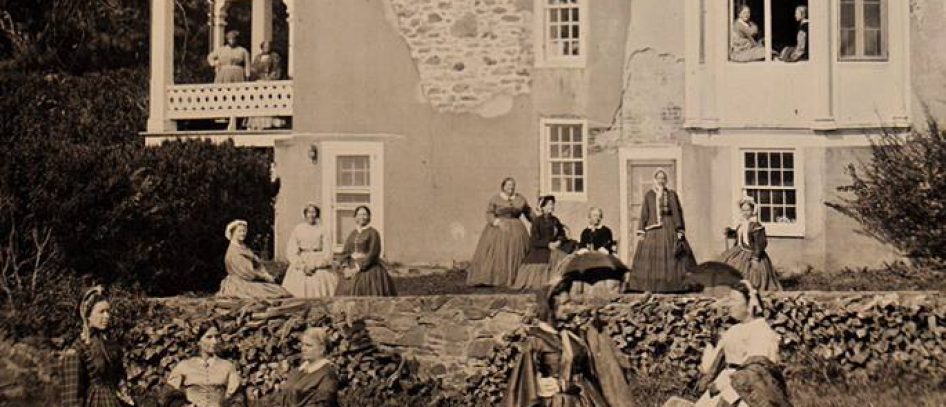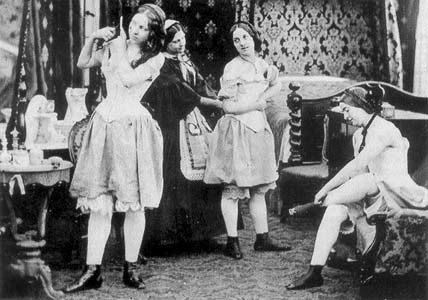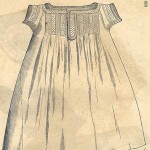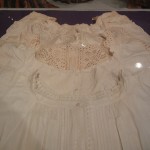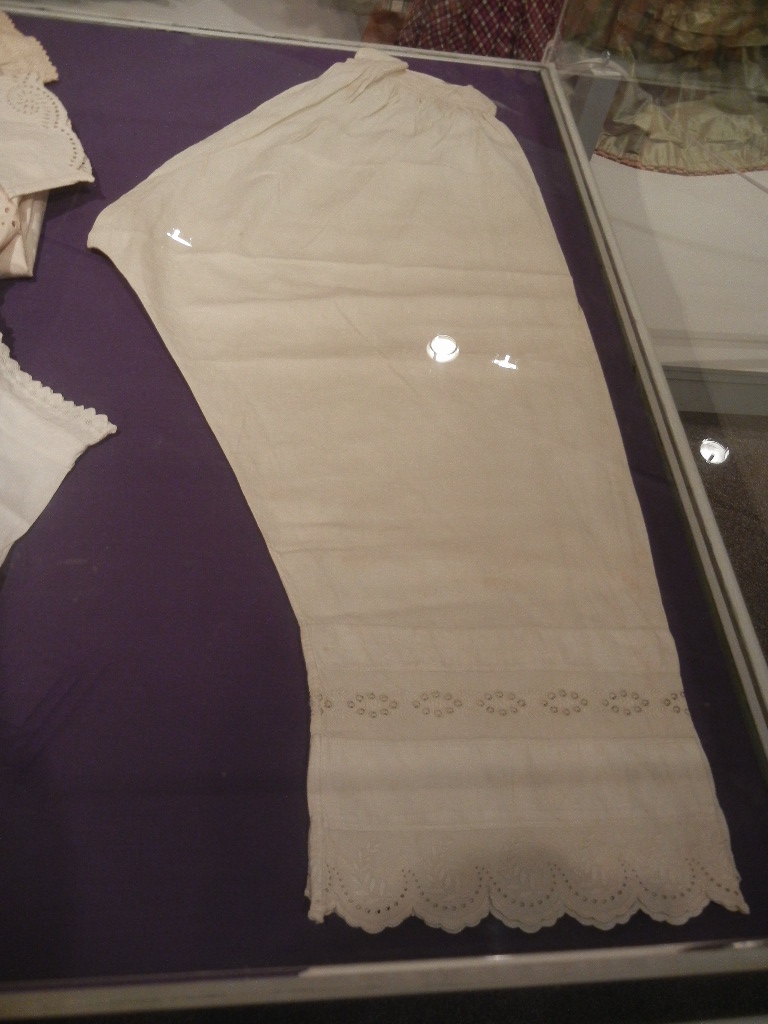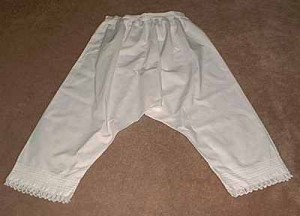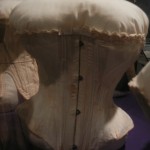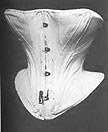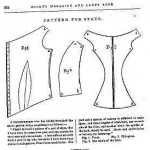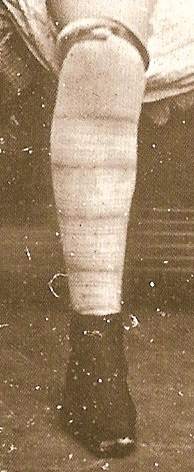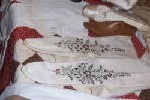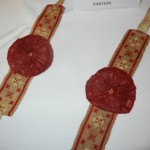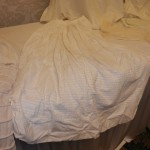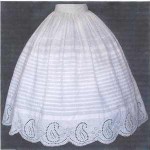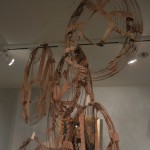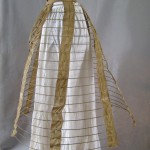To achieve the silhouette of the women of the 1860s, it really is necessary to have well fitted, correct undergarments. While you can get away with not having all the necessary items, you will not truly look the part without the right foundation. As with everything else, your undergarments will be dictated by your impression. This page will examine the different undergarments from the inside out. For further review of Chemise and Drawers construction and information, see my Blog post “Undies“.
Chemise
The chemise is a basic undergarment. It protects your outer garment and, when wearing a corset, serves as a buffer between your skin and the corset; before trying to wear your corset, be sure you have a chemise to go under it.
The chemise is always white and can be plain with no decoration or elaborate with tucks or embroidery. The most common fabrics include muslin, Pima cotton or fine linen. It can be sleeveless or with sleeves and is loose bodied. The length is between the thigh and knee.
There are two camps regarding how to wear it–either tucked into the drawers or left out over the drawers. This decision is entirely up to you.
Commercial Patterns are available from various companies or simple instructions for making a chemise are available on Elizabeth Stewart Clark’s web site. You can also purchase ready made garments for several different vendors.
Drawers (NOT pantaloons, pantalettes, or bloomers)
Drawers are not a necessity; they were just coming into fashion as the crinoline appeared. However, if you are wearing hoops you may want to wear them for warmth and/or modesty. If you choose to wear them, you will find that authentically constructed drawers (without a crotch seam) are much more convenient than modern underwear while wearing period clothes.
Drawers are white and made of cotton, muslin, linen, or flannel and usually button in the back. They can be plain or fancy with tucks, embroidery, or whitework. They are worn to just below the knee to mid-calf.
Elizabeth Stewart Clark’s web site also includes instructions for drawer construction, commercial patterns are also available or ready made garments can be purchased from different vendors.
Foundation Garment
Some type of period foundation garment should be worn, whether it is a fully boned corset or working stays. These garments will give you not only support but also the proper shape of a woman from the 1860s; modern bras or “merry widow” corsets do not give the correct shape of the period. Generally, a corset is appropriate for most middle class impressions. Stays, on the other hand would be more appropriate in a working impression or an impression of a lower class woman.
Corset
A corset in the 1860s is not intended to make the waist small, but rather hold everything in place. It is usually gussetted or shaped, and boned. They are made out of coutil and can be different colors, but usually white or beige. 1860s corsets are hooked with a busk in front and laced up the back with about a three to four inch gap or spring in the back. Corsets were usually store bought during the Civil War era.
Commercial patterns are available as well as ready made garments from various venders. Carolann Schmitt also offers a corset workshop occasionally.
Working Stays
Working stays are less confining than a corset and have shoulder straps. Cords and gussets create the shape. They can be laced either in the front or back. Often homemade of cotille, drill or sateen.
Stockings
Stockings are generally above the knee, held up with garters. They can be colored (white or cream most common however), patterned, embroidered, or plain. To begin with you may wish to purchase cotton knee high socks. There are also patterns for knitted or sewn stockings and garters.
Petticoats
No matter your impression or the style of your wardrobe, a petticoat will always be used. This garment is necessary to give the proper fullness to your dress especially if you do not choose to wear a hoop.
Depending on your impression, you may want more than just one petticoat. If you are wearing hoops a modesty petticoat under the hoops is a necessity along with one to two petticoats over the hoops. If your impression is that of a working class or poor woman, one to two petticoats under your dress is fine.
Petticoats can be of muslin, Pima cotton, flannel, wool, or even appear to be a recycled calico from an old dress. They can also be quilted for extra warmth. They can be plain or decorated with embroidery or tucks. Your petticoats should be hemmed shorter than your dress, but if worn over a crinoline, should cover the hoops completely. Corded petticoats were mostly out of fashion by the Civil War era.
Petticoats are fairly simple to construct; Elizabeth Stewart Clark has free instructions for constructing a basic petticoat. Commercial patterns are also available or you can purchase ready made items.

Cage Crinoline or Hoops
Cage crinolines are know by several names–hoops, expanding skirt, cage, hoop skirt. First patented in the US in 1856, the cage eliminated the multitude of petticoats used to obtain the fashionable domed skirt shape. Later in the war, the hoop shape began to shift to a flatter front and more bulk in the back (elliptical) beginning the evolution of the bustle. Generally, for a war impression the doomed shape is acceptable.
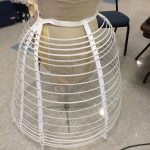
Your decision to wear a hoop and it’s size should be based on your impression and activities at a particular event. Upper and middle class impressions should always include a hoop; lower or working impressions do not necessarily need one. You should avoid the large hoops satirized in period cartoons even at a ball. A good size range is 90 to 108 inches in circumference. A cage for a ball could expand to 120 inches.
Many vendors supply hoop kits, supplies and ready made hoops. Recently, we have had an issue finding the correct hoop wire as the only company to manufacture the wire has discontinued production. You may have to search a bit to find the necessary wires for the foreseeable future. You should avoid modern bridal hoops if at all possible.
